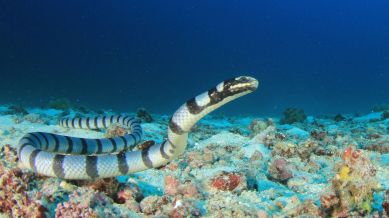📣 For more lifestyle news, click here to join our WhatsApp Channel and also follow us on Instagram
Meet the most venomous marine snake
These snakes are commonly found in reef flats, and along sandy or silty seabeds often blanketed with seaweed, corals, and sponges. These environments not only give them great camouflage but also provide perfect hunting grounds.

When we think of venomous snakes, our minds usually go to rattlesnakes or cobras. But the title of most venomous marine snake, and one of the deadliest snakes in the world, actually belongs to a far lesser-known serpent that lives under the waves of the ocean. Say hello to the Dubois’ seasnake (Aipysurus duboisii), a relatively small but incredibly toxic snake found in tropical waters off Australia, Papua New Guinea, and New Caledonia.
Dubois’ seasnakes are marine through and through. You won’t see them slithering on land, they even give birth to live young underwater and spend their entire lives in the ocean. They’re commonly found in reef flats, and along sandy or silty seabeds often blanketed with seaweed, corals, and sponges. These environments not only give them great camouflage but also provide perfect hunting grounds.
monthly limit of free stories.
with an Express account.
They usually stay within shallow areas but have been spotted at depths of up to 80 meters (about 260 feet). As adults, they typically grow to around 80 cm, though some individuals can reach up to 148 cm, that’s just under 5 feet.
Not just deadly, they’re extremely deadly
So, what makes this snake so dangerous? It all comes down to venom potency. According to Guinness World Records, the Dubois’ seasnake has an LD50 of 0.044 mg/kg, which is a fancy way of saying that a very, very tiny amount of its venom is enough to be lethal. As Guinness puts it, “this makes A duboisii not only the most venomous seasnake but one of the most venomous snakes in the world overall.”
Despite this, actual bites are quite rare. The snake isn’t aggressive toward humans and usually only strikes if it feels cornered, often when it’s accidentally pulled up in fishing nets. But if a bite does happen, the danger is real. The venom contains a mix of neurotoxins and myotoxins, which can cause paralysis, muscle breakdown, and kidney damage.
Early symptoms might seem mild; numbness, a bit of weakness, but things can escalate fast if untreated. That’s why experts recommend immediate pressure-immobilisation first aid and getting to a hospital quickly for antivenom.
Built for the reef life
Anatomically, the Dubois’ seasnake is a fascinating creature. It has a paddle-shaped tail that helps it swim, and a head that’s just slightly wider than its neck. Its dorsal scales are generally smooth, though they can be slightly keeled, and its fangs are quite short, only about 1.8 mm long. Even so, that’s all it needs to deliver venom that can take down far larger animals.
In fact, one of its go-to meals is moray eels, sometimes longer than the snake itself. It also hunts reef fish, using ambush tactics in the narrow crevices and nooks of coral structures.
Despite how lethal it is on paper, this snake isn’t some nightmare predator lurking in the shadows. Most people will never encounter one, and those who do almost always walk, or swim, away without harm. Conservation-wise, it’s listed as a species of Least Concern, although bycatch (getting caught in fishing nets) remains a potential threat.
📣 For more lifestyle news, click here to join our WhatsApp Channel and also follow us on Instagram